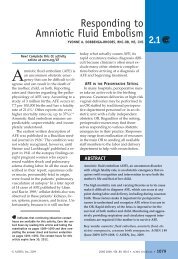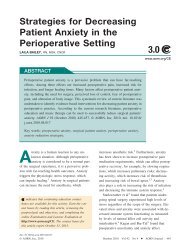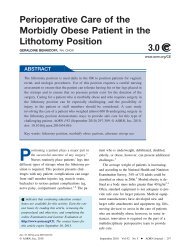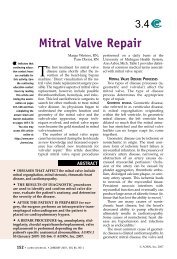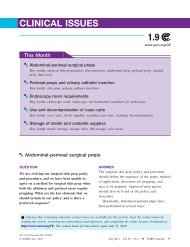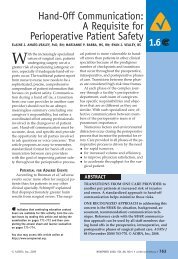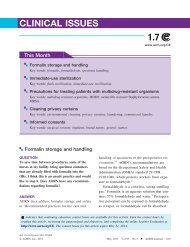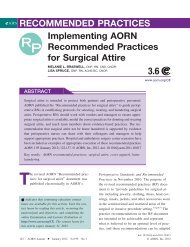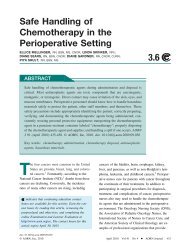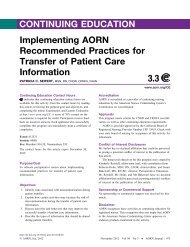Emergence Delirium: A Nursing Perspective - AORN
Emergence Delirium: A Nursing Perspective - AORN
Emergence Delirium: A Nursing Perspective - AORN
You also want an ePaper? Increase the reach of your titles
YUMPU automatically turns print PDFs into web optimized ePapers that Google loves.
MARCH 2009, VOL 89, NO 3Hudekmembers. 2,4 <strong>Emergence</strong> delirium can increase patientcosts because of the increased length oftime spent in the PACU, extra pharmaceuticalsused to try to resolve the emergence delirium orto protect the patient, repair of any physicaldamage the patient may cause to himself or herself,and the cost for an increased number ofstaff members to care for the patient. 2,4 It is importantthat nurses, physicians, and anesthesiacare providers work together to recognize patientsat risk for emergence delirium, reduce itsoccurrence whenever possible, and successfullytreat it when it occurs.CONCLUSIONThe final diagnosis for Abby was an “adversereaction to anesthesia.” She returned tothe admitting hospital for follow up twoweeks after her transfer. She was in good spiritsand was having no notable ill effects fromher experience. She had no recollection ofwhat had happened in the PACU. Abby recalledjoking with the anesthesia care providerin the preoperative holding area and thenwaking up in the facility to which she wastransferred. For the patient, it did not appearto be a traumatic experience; however, it is animportant part of her medical history thatshould be taken into consideration in any futuresurgical experiences.REFERENCES1. Burns SM. <strong>Delirium</strong> during emergence fromanesthesia: a case study. CritCare Nurse. 2003;23(1):66-69.2. Lepousé C, Lautner CA, Liu L, Gomis P, Leon A.<strong>Emergence</strong> delirium in adults in the post-anesthesiacare unit. Br J Anaesth. 2006;96(6):747-753.3. Mason LJ. Pitfalls of pediatric anesthesia. Societyfor Pediatric Anesthesia. http://www.pedsanesthesia.org/meetings/2004winter/pdfs/mason_Pitfalls.pdf.Accessed January 28, 2009.4. Neugeborn I. <strong>Emergence</strong> delirium. DownstateAnesthesia. http://downstateanesthesia.org/Education/Optimized%20Files/<strong>Emergence</strong>%20<strong>Delirium</strong>.ppt. Accessed January 10, 2009.5. Wells LT, Rasch DK. <strong>Emergence</strong> “delirium” aftersevoflurane anesthesia: a paranoid delusion? AnesthAnalg. 1999;88(6):1308-1310.6. Kain Z, Caldwell-Andrews A, Maranets I, et al.Preoperative anxiety and emergence delirium andpostoperative maladaptive behaviors. Anesth Analg.2004;99(6):1648-1654.7. Riker RR, Fraser GL, Simmons LE, Wilkins ML.Validating the sedation-agitation scale with theBispectral Index and Visual Analog Scale in adultICU patients after cardiac surgery. Intensive CareMed. 2001;27(5):853-858.8. Riker RR, Fraser GL. Monitoring sedation, agitation,analgesia, neuromuscular blockade, and deliriumin adult ICU patients. Semin Respir Crit Care Med.2001;22(2):189-198.9. Sessler CN, Gosnell MS, Grap MJ, et al. TheRichmond Agitation-Sedation Scale: validity andreliability in adult intensive care unit patients. AmJ Respir Crit Care Med. 2002;166(10):1338-1344.Kim Hudek, RN, BScN, MEd, CNOR, is aperioperative nurse at Western Arizona RegionalMedical Center, Bullhead City, AZ.Ms Hudek has no declared affiliation that couldbe perceived as a potential conflict of interest inpublishing this article.516 • <strong>AORN</strong> JOURNAL



